steering MAZDA MODEL 3 HATCHBACK 2020 (in English) Owner's Manual
[x] Cancel search | Manufacturer: MAZDA, Model Year: 2020, Model line: MODEL 3 HATCHBACK, Model: MAZDA MODEL 3 HATCHBACK 2020Pages: 598, PDF Size: 89.37 MB
Page 186 of 598

Direct Mode*
▼Direct Mode
Direct mode can be u
sed for temporarily
switching gears by operating the steering
shift switch while the vehicle is being
driven with the selector lever in the D
position.
While in direct mode, the D and M
indication illuminate a nd the gear position
in use is illuminated.
1. Direct mode indication
2. Gear position indication
Direct mode is canceled (released) under
the following conditions.
The UP switch (+/OFF) is pulled
rearward for a certain amount of time or
longer.
The vehicle is driven for a certain
amount of time or longer (time differs
depending on the driving conditions
while operating).
The vehicle is stopped or moving at a
slow speed.
NOTE
Shifting up and down while in direct mode
may not be possible depending on the
vehicle speed. In addition, because direct
mode is canceled (released) depending on
the rate of acceleration or if the
accelerator is fully depressed, use of the
manual shift mode is recommended if you
need to drive the ve hicle in a particular
gear for long periods.
When Driving
Automatic Transmission
4-42*Some models.
Mazda3_8HZ1-EA-19G_Edition1_old 2019-5-17 13:49:03
Page 187 of 598
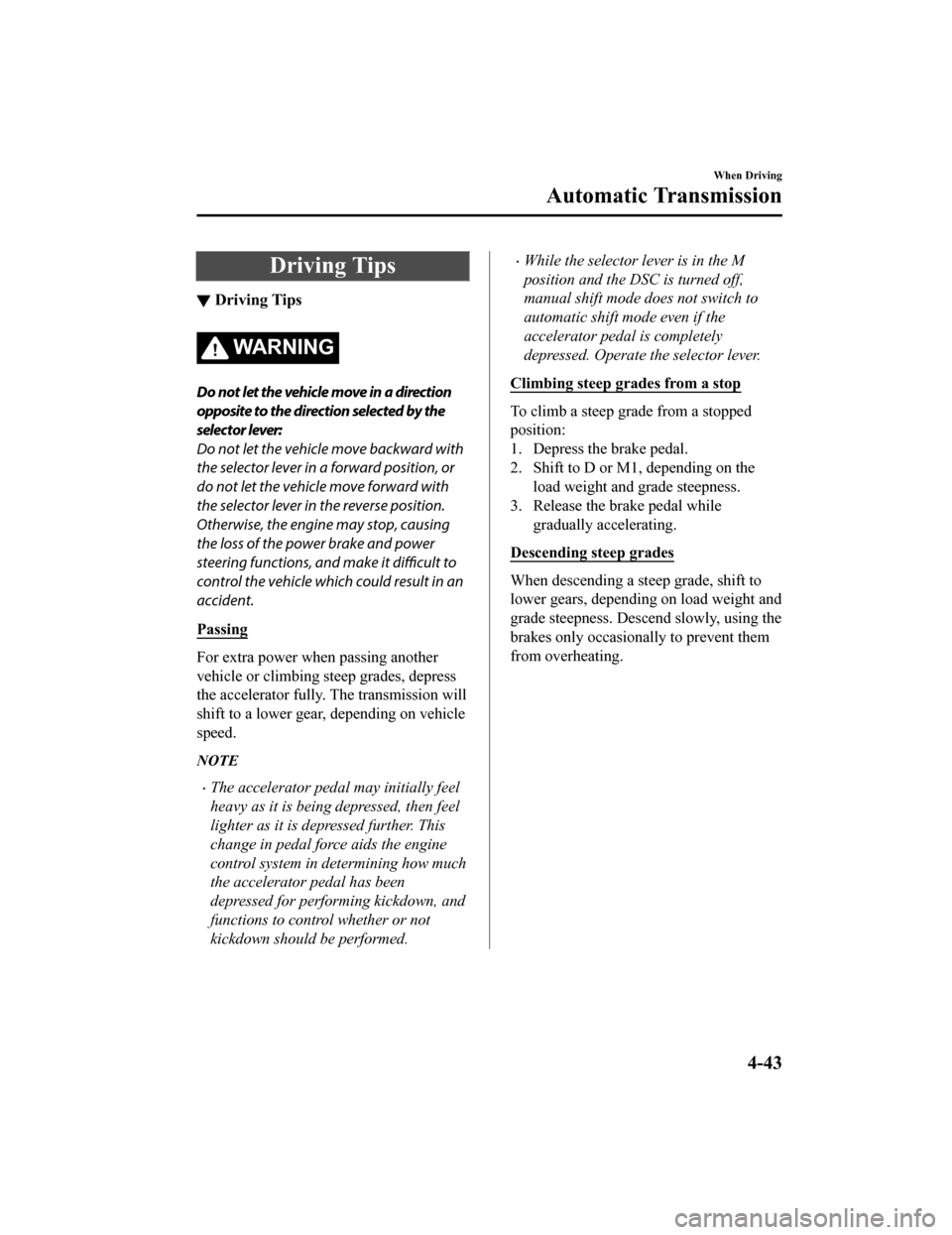
Driving Tips
▼Driving Tips
WA R N I N G
Do not let the vehicle move in a direction
opposite to the direction selected by the
selector lever:
Do not let the vehicle move backward with
the selector lever in a forward position, or
do not let the vehicle move forward with
the selector lever in the reverse position.
Otherwise, the engine may stop, causing
the loss of the power brake and power
steering functions, and make it
difficult to
control the vehicle which could result in an
accident.
Passing
For extra power when passing another
vehicle or climbing steep grades, depress
the accelerator fully. The transmission will
shift to a lower gear, depending on vehicle
speed.
NOTE
The accelerator pedal may initially feel
heavy as it is being depressed, then feel
lighter as it is depressed further. This
change in pedal force aids the engine
control system in determining how much
the accelerator pedal has been
depressed for performing kickdown, and
functions to control whether or not
kickdown should be performed.
While the selector lever is in the M
position and the DSC is turned off,
manual shift mode does not switch to
automatic shift mode even if the
accelerator pedal is completely
depressed. Operate the selector lever.
Climbing steep grades from a stop
To climb a steep grade from a stopped
position:
1. Depress the brake pedal.
2. Shift to D or M1, depending on the load weight and grade steepness.
3. Release the brake pedal while gradually accelerating.
Descending steep grades
When descending a steep grade, shift to
lower gears, depending on load weight and
grade steepness. Desce nd slowly, using the
brakes only occasionally to prevent them
from overheating.
When Driving
Automatic Transmission
4-43
Mazda3_8HZ1-EA-19G_Edition1_old 2019-5-17 13:49:03
Page 201 of 598
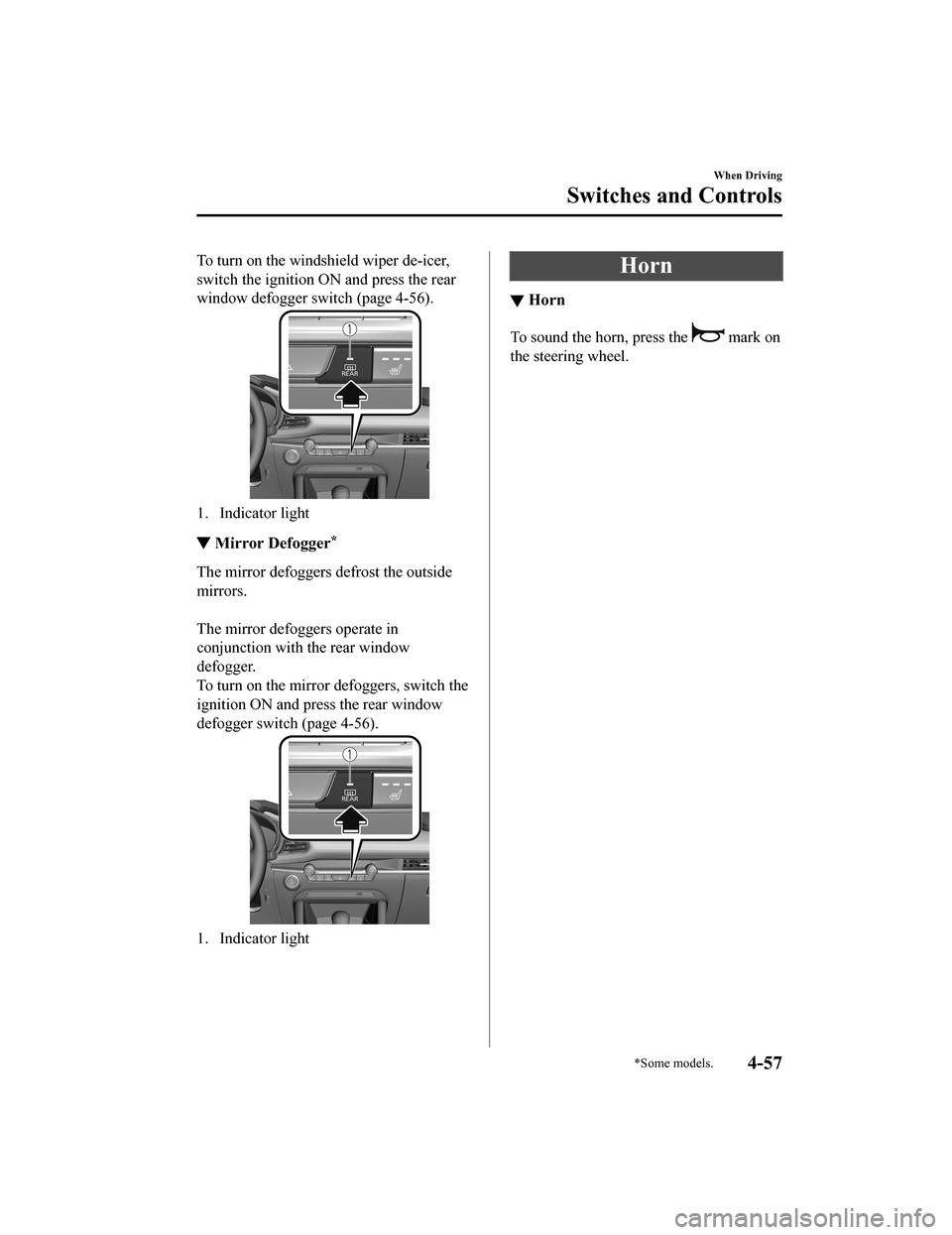
To turn on the windshield wiper de-icer,
switch the ignition ON and press the rear
window defogger switch (page 4-56).
1. Indicator light
▼Mirror Defogger*
The mirror defoggers defrost the outside
mirrors.
The mirror defoggers operate in
conjunction with the rear window
defogger.
To turn on the mirror defoggers, switch the
ignition ON and press the rear window
defogger switch (page 4-56).
1. Indicator light
Horn
▼Horn
To sound the horn, press the mark on
the steering wheel.
When Driving
Switches and Controls
*Some models.4-57
Mazda3_8HZ1-EA-19G_Edition1_old 2019-5-17 13:49:03
Page 213 of 598

AUTOHOLD
▼AUTOHOLD
The AUTOHOLD function automatically holds the vehicle stopped,
even if you take your
foot off the brake pedal. This function can be best used while stopped in traffic or at a traffic
light. The brakes are released w hen you start driving the vehicle.
WA R N I N G
Do not rely completely on the AUTOHOLD function:
The AUTOHOLD function is only designed to assist the brake operation while the vehicle is
stopped. Neglecting to operate the brakes and relying only on the AUTOHOLD system is
dangerous and could result in an unexpected accident if the vehicle were to suddenly move.
Operate the brakes appr opriately in accordance with the road and surrounding conditions.
Do not release your foot from the brake pedal while the vehicle is stopped on a steep grade:
Because there is a possibility of the vehicle no t being held in the stopped position by the
AUTOHOLD function, the vehicle may move unexpectedly and result in an accident.
Do not use the AUTOHOLD function on slippery roads such as icy or snow-covered roads, or
unpaved roads:
Even if the vehicle is held in the stopped posi tion by the AUTOHOLD function, the vehicle may
move unexpectedly and result in an accident. Operate the accelerator pedal, brakes, or
steering wheel appropriately as necessary.
Immediately depress the brake pedal in the following cases:
Because the AUTOHOLD function is canceled forcibly, the vehicle may move unexpectedly
and result in an accident.
“Depress Brake Pedal. Brake Hold Disabled” is displayed in the multi-information display
and the warning sound is activated at the same time.
Always apply the parking brake when parking the vehicle:
Not applying the parking brake when parking the vehicle is dangerous as the vehicle may
move unexpectedly and result in an accident . When parking the vehicle, shift the selector
lever to the P position (automatic transmi ssion vehicle) and apply the parking brake.
When Driving
Brake
4-69
Mazda3_8HZ1-EA-19G_Edition1_old 2019-5-17 13:49:03
Page 223 of 598

Drive Selection*
▼Drive Selection
Drive selection is a system to switch the
vehicle's drive mode. When the sport
mode is selected, vehicle's response
against accelerator operation is enhanced.
This provides additional quick
acceleration which may be needed to
safely make maneuvers such as lane
changes, merging onto freeways, or
passing other vehicles.
CAUTION
Do not use the sport mode when driving on
slippery roads such as wet or snow-covered
roads. It may cause tire slipping.
NOTE
When the sport mode is selected, driving
at higher engine speeds increases and it
may increase fuel consumption. Mazda
recommends that you cancel the sport
mode on normal driving.
Drive mode cannot be switched in the
following conditions:
ABS/TCS/DSC is operating
Cruise control* is operating.
The Mazda Radar Cruise Control with
Stop & Go function (MRCC with Stop
& Go function) System
* is operating.
Traffic Jam Assist (TJA)* is operating.
Steering wheel is being operated
abruptly
▼Drive Selection Switch
Press the drive sele
ction switch forward
(SPORT) to select the sport mode.
Pull the drive selecti on switch back (OFF)
to cancel the sport mode.
NOTE
In the following cases, the drive
selection is canceled.
The ignition is switched OFF.
Cruise Control is set.
Mazda Radar Cruise Control with
Stop & Go function (MRCC with Stop
& Go function) is set.
Traffic Jam Assist (TJA) is set.
Depending on the driving conditions
when sport mode is selected, the vehicle
may perform shift-down or slightly
accelerate.
When Driving
Drive Selection
*Some models.4-79
Mazda3_8HZ1-EA-19G_Edition1_old 2019-5-17 13:49:03
Page 225 of 598
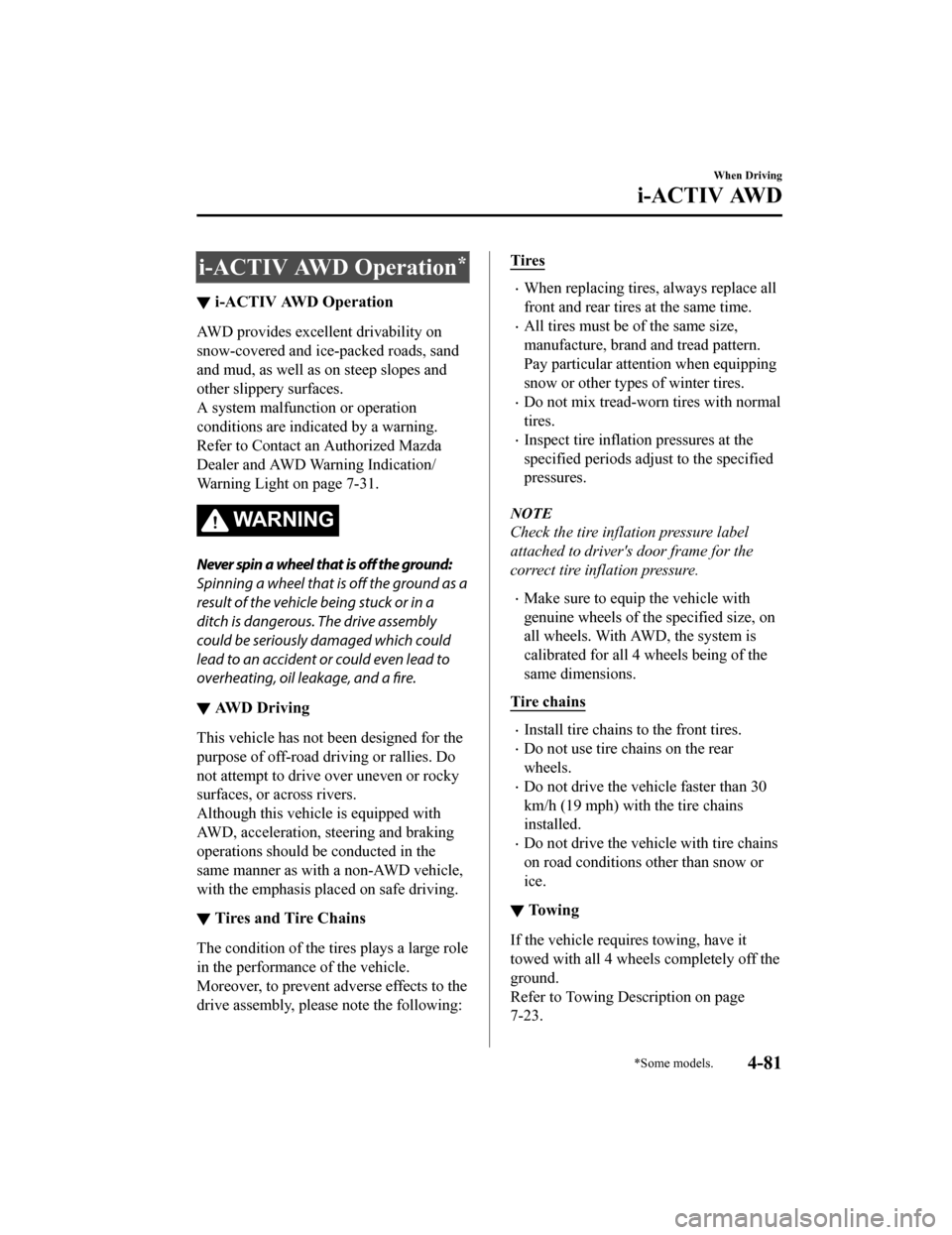
i-ACTIV AWD Operation*
▼i-ACTIV AWD Operation
AWD provides excellent drivability on
snow-covered and ice-packed roads, sand
and mud, as well as on steep slopes and
other slippery surfaces.
A system malfunction or operation
conditions are indicated by a warning.
Refer to Contact a
n Authorized Mazda
Dealer and AWD Warning Indication/
Warning Light on page 7-31.
WA R N I N G
Never spin a wheel that is off the ground:
Spinning a wheel that is off the ground as a
result of the vehicle being stuck or in a
ditch is dangerous. The drive assembly
could be seriously damaged which could
lead to an accident or could even lead to
overheating, oil leakage, and a fire.
▼ AWD Driving
This vehicle has not been designed for the
purpose of off-road driving or rallies. Do
not attempt to drive over uneven or rocky
surfaces, or across rivers.
Although this vehicle is equipped with
AWD, acceleration, steering and braking
operations should be conducted in the
same manner as with a non-AWD vehicle,
with the emphasis placed on safe driving.
▼Tires and Tire Chains
The condition of the tires plays a large role
in the performance of the vehicle.
Moreover, to prevent adverse effects to the
drive assembly, please note the following:
Tires
When replacing tires, always replace all
front and rear tires at the same time.
All tires must be of the same size,
manufacture, brand and tread pattern.
Pay particular attention when equipping
snow or other types of winter tires.
Do not mix tread-worn tires with normal
tires.
Inspect tire inflation pressures at the
specified periods adjust to the specified
pressures.
NOTE
Check the tire inflation pressure label
attached to driver's door frame for the
correct tire inflation pressure.
Make sure to equip the vehicle with
genuine wheels of the specified size, on
all wheels. With AWD, the system is
calibrated for all 4 wheels being of the
same dimensions.
Tire chains
Install tire chains to the front tires.
Do not use tire chains on the rear
wheels.
Do not drive the vehicle faster than 30
km/h (19 mph) with the tire chains
installed.
Do not drive the vehicle with tire chains
on road conditions other than snow or
ice.
▼ To w i n g
If the vehicle requires towing, have it
towed with all 4 wheels completely off the
ground.
Refer to Towing Description on page
7-23.
When Driving
i-ACTIV AWD
*Some models.4-81
Mazda3_8HZ1-EA-19G_Edition1_old
2019-5-17 13:49:03
Page 226 of 598

Power Steering
▼Power Steering
Power steering is only operable when
the engine is running. If the engine is off
or if the power steering system is
inoperable, you can still steer, but it
requires more physical effort.
If the steering feel
s stiffer than usual
during normal driving or the steering
vibrates, consult an Authorized Mazda
Dealer.
The warning indication notifies the
driver of system abnormalities and
operation conditions.
Refer to Power Steering Malfunction
Indication/Indicator Light on page
7-29.
When Driving
Power Steering
4-82
Mazda3_8HZ1-EA-19G_Edition1_old 2019-5-17 13:49:03
Page 232 of 598
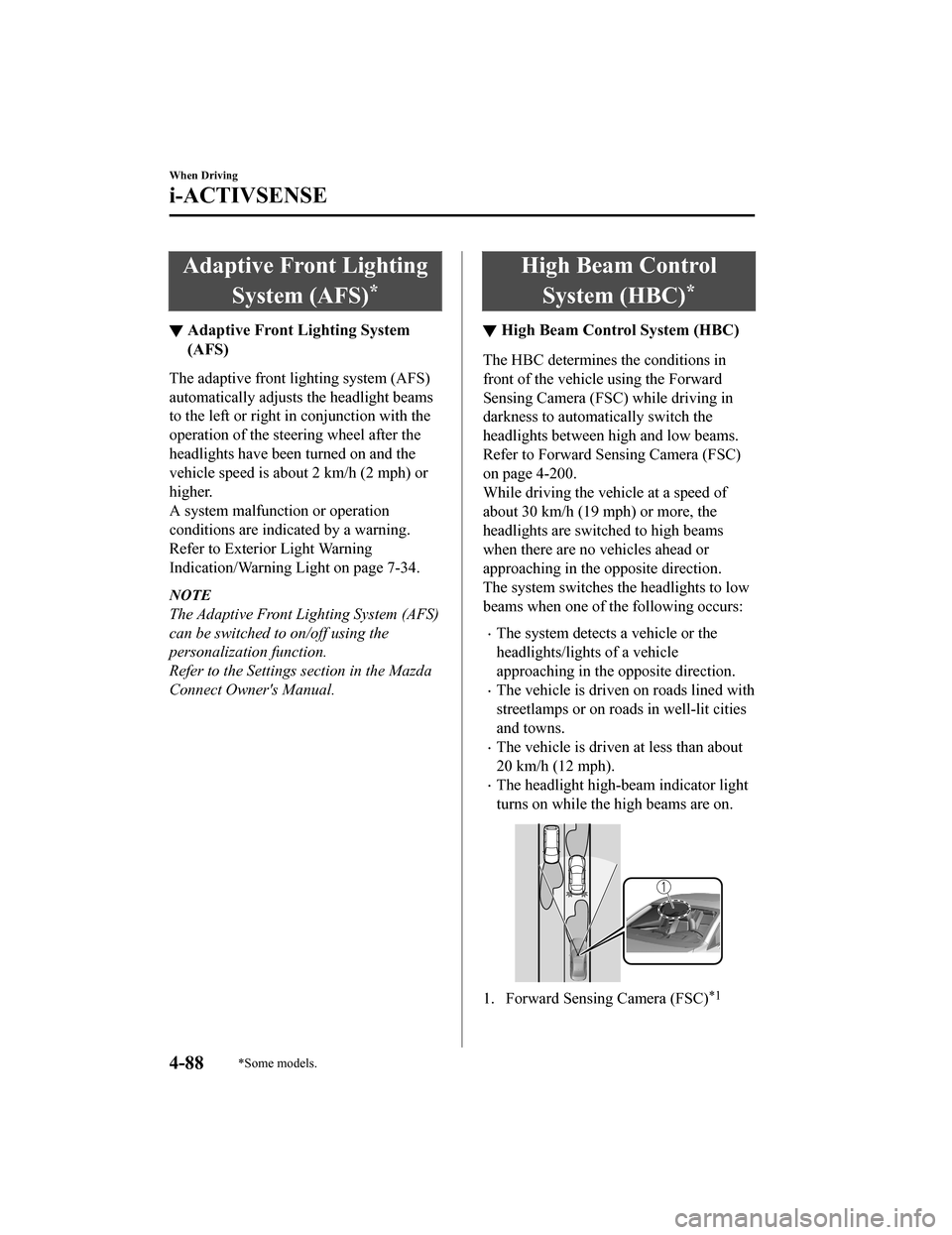
Adaptive Front LightingSystem (AFS)
*
▼Adaptive Front Lighting System
(AFS)
The adaptive front lighting system (AFS)
automatically adjusts
the headlight beams
to the left or right i n conjunction with the
operation of the steering wheel after the
headlights have been turned on and the
vehicle speed is about 2 km/h (2 mph) or
higher.
A system malfunction or operation
conditions are indicated by a warning.
Refer to Exterior Light Warning
Indication/Warning Light on page 7-34.
NOTE
The Adaptive Front Lighting System (AFS)
can be switched to on/off using the
personalization function.
Refer to the Settings section in the Mazda
Connect Owner's Manual.
High Beam Control
System (HBC)
*
▼ High Beam Control System (HBC)
The HBC determines the conditions in
front of the vehicle using the Forward
Sensing Camera (FSC) while driving in
darkness to automatically switch the
headlights between high and low beams.
Refer to Forward Sensing Camera (FSC)
on page 4-200.
While driving the vehicle at a speed of
about 30 km/h (19 mph) or more, the
headlights are switc
hed to high beams
when there are no vehicles ahead or
approaching in the opposite direction.
The system switches the headlights to low
beams when one of the following occurs:
The system detects a vehicle or the
headlights/lights of a vehicle
approaching in the opposite direction.
The vehicle is driven on roads lined with
streetlamps or on road s in well-lit cities
and towns.
The vehicle is driven at less than about
20 km/h (12 mph).
The headlight high-beam indicator light
turns on while the high beams are on.
1. Forward Sensing Camera (FSC)*1
When Driving
i-ACTIVSENSE
4-88*Some models.
Mazda3_8HZ1-EA-19G_Edition1_old 2019-5-17 13:49:03
Page 235 of 598
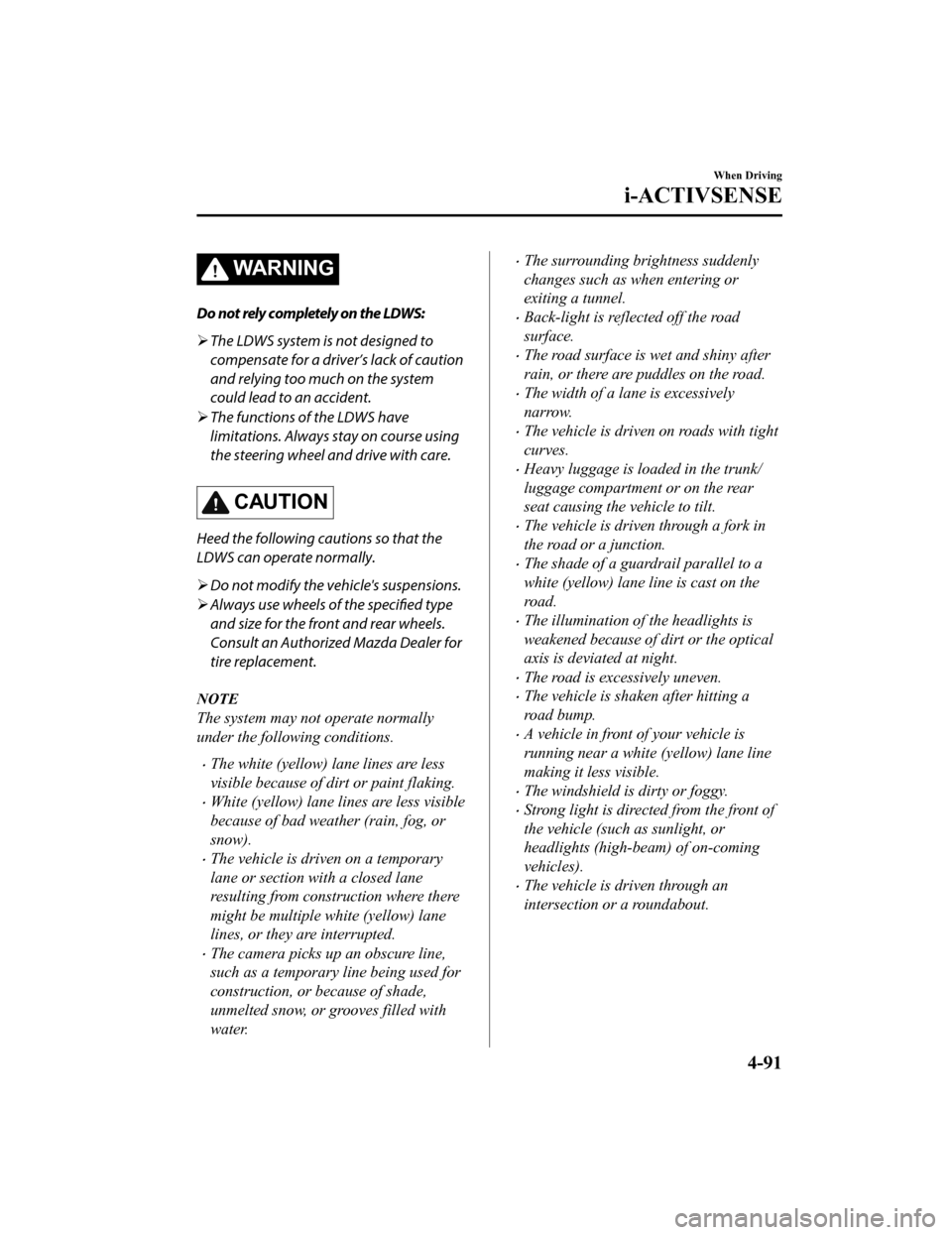
WA R N I N G
Do not rely completely on the LDWS:
The LDWS system is not designed to
compensate for a driver’s lack of caution
and relying too much on the system
could lead to an accident.
The functions of the LDWS have
limitations. Always stay on course using
the steering wheel and drive with care.
CAUTION
Heed the following cautions so that the
LDWS can operate normally.
Do not modify the vehicle's suspensions.
Always use wheels of the
specified type
and size for the front and rear wheels.
Consult an Authorized Mazda Dealer for
tire replacement.
NOTE
The system may not operate normally
under the following conditions.
The white (yellow) lane lines are less
visible because of di rt or paint flaking.
White (yellow) lane lines are less visible
because of bad weather (rain, fog, or
snow).
The vehicle is driven on a temporary
lane or section with a closed lane
resulting from construction where there
might be multiple white (yellow) lane
lines, or they are interrupted.
The camera picks up an obscure line,
such as a temporary line being used for
construction, or because of shade,
unmelted snow, or grooves filled with
water.
The surrounding brightness suddenly
changes such as when entering or
exiting a tunnel.
Back-light is reflected off the road
surface.
The road surface is wet and shiny after
rain, or there are puddles on the road.
The width of a lane is excessively
narrow.
The vehicle is driven on roads with tight
curves.
Heavy luggage is loaded in the trunk/
luggage compartment or on the rear
seat causing the vehicle to tilt.
The vehicle is driven through a fork in
the road or a junction.
The shade of a guardrail parallel to a
white (yellow) lane line is cast on the
road.
The illumination of the headlights is
weakened because of dirt or the optical
axis is deviated at night.
The road is excessively uneven.
The vehicle is shaken after hitting a
road bump.
A vehicle in front of your vehicle is
running near a white (yellow) lane line
making it less visible.
The windshield is dirty or foggy.
Strong light is directed from the front of
the vehicle (such as sunlight, or
headlights (high-beam) of on-coming
vehicles).
The vehicle is driven through an
intersection or a roundabout.
When Driving
i-ACTIVSENSE
4-91
Mazda3_8HZ1-EA-19G_Edition1_old 2019-5-17 13:49:03
Page 236 of 598

▼When the System Operates
When the ignition is switched ON, the
i-ACTIVSENSE status symbol (warning/
risk avoidance support system) (white)
turns on and the system goes on standby.
NOTE
If the i-ACTIVSENSE status symbol
(warning/risk avoidance support system)
(white) does not turn on, the system is
canceled using the i-ACTIVSENSE switch
or the personalization feature.
Operation conditions
When all of the foll
owing conditions are
met, the i-ACTIVSE NSE status symbol
(warning/risk avoidance support system)
on the multi-information display changes
from white to green and the system
becomes operational.
The ignition i s switched ON.
The vehicle speed is about 64 km/h (40
mph) or faster.
The system detects white (yellow) lane
lines.
NOTE
When the system does not detect a white
(yellow) lane line on one side only, the
system does not operate on the side that is
not being detected.
When temporarily canceling the system
The LDWS goes on standby in the
following cases: The LDWS operation is
automatically restored when the system's
operation conditions are met.
The system cannot detect white (yellow)
lane lines.
The vehicle speed is less than about 56
km/h (35 mph).
The turn signal lever is operated.
The accelerator pedal is depressed.
The steering wheel is operated.
The brake pedal is operated.
The function is temporarily stopped.
The LDWS stops functioning in the
following cases:
The temperature in the forward sensing
camera (FSC) is high or low.
The windshield around the forward
sensing camera (FSC) is foggy.
The windshield around the forward
sensing camera (FSC) is blocked by an
obstruction, causing poor forward
visibility.
When Driving
i-ACTIVSENSE
4-92
Mazda3_8HZ1-EA-19G_Edition1_old 2019-5-17 13:49:03